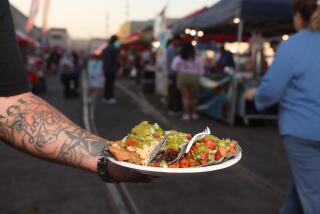Why May the Chickens Hit the Road?
- Share via
SAN JUAN BAUTISTA, Calif. — If you’re a chicken, this picturesque little burg is close to paradise.
You and a few hundred pals have the run of downtown, strutting down sidewalks and across streets without fear of winding up fricasseed. Kindly locals buy sacks of feed for you, diners at outdoor restaurants throw scraps to you and camera-toting tourists ooh-and-aah all over you. Just for being poultry, you get all that -- plus plenty of roosting spots in low-lying tree limbs, to the occasional chagrin of the poor saps walking below.
But on Tuesday, City Council members might just tell the chickens that have freely roamed the old mission town for generations to go suck an egg. After years of intermittent and sometimes bitter debate, the council will consider making it illegal to feed the famous feral fowl of San Juan Bautista.
“It’s a policy issue the council is wrestling with,” said City Manager Janice McClintock, who stepped into the long-simmering chicken dispute as soon as she started her job just five weeks ago. “Both the pro-chicken and the anti-chicken forces make some good points.”
In a town of fewer than 2,000, almost everyone has a well-defined point of view when it comes to the chickens. The pro-chicken forces in this hamlet 45 miles south of San Jose talk up civic identity; the anti-chicken forces mutter darkly about bird flu. The boosters point to delighted tourists; the critics point to speckled sidewalks.
At San Benito Bank in the center of town, customer service manager Lisa Estabrooks recently put up hand-written “Please do not feed the chickens” signs on the trees outside.
“Personally, I have nothing against them,” she said, “but many of my customers complain.”
Little old ladies have been intimidated by aggressive roosters at the front door, she said. And, with the bank occupying a corner well-loved by chickens, Estabrooks has been as appalled by the deposits that stay outside as those that get tracked in.
A few weeks ago, she hired a sandblaster to clear the sidewalk. The job took five hours.
“It was an absolute mess,” she said. “A big, piled-up mess.”
Down the street at popular Mexican restaurant Jardines de San Juan, manager Susan Botelho ruefully acknowledged that many tourists love to sit on her patio dropping tortilla chips for the eagerly waiting chickens.
But at the same time, she said, roosters crow so loudly that they sometimes overwhelm the soft strains of guitarists playing in the courtyard. They tear up the restaurant’s elaborate gardens, and some have even leaped onto the tables of startled guests.
“Their droppings are everywhere, and we have to clean up after them constantly,” she said, suspiciously eyeing a gorgeously colored rooster as he sauntered past the patio into a bed of elegant long grasses.
Nobody seems to know which came first, the chickens of San Juan Bautista or the notion that they would be a problem. And nobody has been able to agree on just what to do; the measure now under discussion was drafted in the 1990s but never enacted.
Now, according to some city officials, there are simply too many chickens. Families with unwanted chickens have been known to furtively drop them off in town, and the well-intended scattering of feed for the critters hasn’t helped, officials say.
Under the proposed Section 170, Title 5, Chapter 7, of the San Juan Bautista Municipal Code, no punishment is set for illicit feeders. However, code violations generally would cost offenders $50 the first time and $100 for another infraction within 12 months.
Cracking down on them might fall to the town’s code enforcement officer, as local police are less than enthusiastic about barking out orders like: “Back away from the chicken! Drop the breadcrumbs now!”
San Benito County Sheriff Curtis J. Hill said his deputies had better things to do than poultry patrol.
“We are not going to put even a drop of ink to any citation,” he said. “Period.”
That’s just fine with folks like Patricia Bains, who feeds the chickens in a vacant lot near the store where she sells vintage clothing and gifts.
“They know my car,” she said. “They know my footsteps. If they’re having a problem, they’ll tend to come into my shop, talk a little bit, and let me know what it is.”
Bains, who hauls around 50-pound sacks of feed in her car, grows animated when she talks about the toddler she saw sharing bits of brownie with chickens on the street.
“How can you have an ordinance against kindness and humanity?” she asked. “They’re living creatures -- and they’re a part of us here.”
According to local lore, the chickens may first have come to town with the monks who built its centerpiece mission in 1797. But whether or not the fryers were the friars’, they have become San Juan Bautista’s dominant symbol. Nearly every shop window features a chicken figurine or a chicken photo or a chicken stuffed toy. The Chamber of Commerce showcases a chicken on its website.
Until a few weeks ago, there were a lot more actual chickens poking through yards and, for reasons unknowable, crossing roads. To thin the flock, the city rounded up 60 or 70 and gave them to local ranchers, said McClintock, the city manager, who figured there might be more than 300 still at large.
By any count, that’s a load of chickens -- especially at 3:30 a.m., when the roosters start the crowing that echoes through town day and night.
Taking a break from painting a church parish hall on Muckelemi Street, Rick Miranda, a descendant of one of the town’s pioneer families, cocked an ear as the familiar cry erupted from one of half a dozen roosters in a grassy lot across the street.
“A great sound,” he said, “if you’re a farmer.”
More to Read
Sign up for The Wild
We’ll help you find the best places to hike, bike and run, as well as the perfect silent spots for meditation and yoga.
You may occasionally receive promotional content from the Los Angeles Times.







